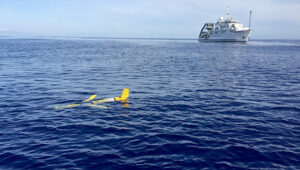A Gaggle of Gliders

The Mid-Atlantic Glider Initiative and Collaboration (MAGIC) program at BIOS uses three underwater robotic vehicles, called gliders, to answer long-standing questions about the ocean’s biological pump, a complex process that converts inorganic carbon dioxide from the atmosphere into organic carbon and exports it to the ocean’s deep layers. The bright yellow, torpedo-shaped gliders dive and climb from the sea surface to depths up to 2,500 feet (900 meters), continuously collecting measurements of ocean properties, such as temperature, salinity, oxygen, pressure, and nutrients.
Just 50 miles (80 kilometers) offshore of Bermuda, an unusual meeting took place this fall—not of people, but of three underwater robotic vehicles called gliders. Two of the gliders are owned and operated by BIOS as part of the Mid-Atlantic Glider Initiative and Collaboration (MAGIC) program. These vehicles, named Anna and Minnie, are equipped with a variety of sensors that measure ocean properties including pressure, temperature, salinity, oxygen, chlorophyll, and nutrients. The gliders have been diving and climbing from between the sea surface and depths near 2,500 feet (900 meters), while tracing a bow-tie-shaped route continuously surveying a 12-square-mile (20-square-kilometer) patch of ocean for the last six months.
They are part of a two year National Science Foundation-funded research program, called the Biological Production and Exports (BPE) experiment, which is seeking information about the ocean’s productivity and carbon cycle. The goal of the project is to resolve several long-standing questions about the ocean’s biological carbon pump, a complex process that converts inorganic atmospheric carbon dioxide into organic carbon and exports it to the ocean’s deep layers.
“Understanding the mechanics of this system and how it will respond to a warming planet has gained urgency in the face of rising greenhouse gases, shifting marine ecosystems, and changing ocean biogeochemisty,” said Ruth Curry, manager of the MAGIC program.
In late October, Curry was contacted by colleagues at Teledyne Webb Research, the Massachusetts-based company that invented and manufactures the gliders, with a unique proposal for a glider meet-up at her study site. Scientists from the Rutgers University Center for Ocean Observing Leadership (COOL) in New Jersey and Teledyne Webb Research were wrapping up the final leg of a five-year global oceanographic investigation called the Challenger Mission. They wanted to know if Curry was interested in having the Challenger Mission’s glider, Silbo, meet up with her gliders on its way from Puerto Rico to Falmouth, Massachusetts. Recognizing the historical appropriateness of this rendezvous, Curry jumped at the opportunity.

In October, two of the MAGIC program gliders, Anna and Minnie, were joined by a third glider, Silbo, which was returning to port after completing the final leg of a five-year global oceanographic investigation called The Challenger Mission. Led by scientists from Rutgers University in New Jersey and Teledyne Webb Research, The Challenger Mission aims to demonstrate the value of robotic vehicles to improving regional and global weather forecasting models. Silbo’s measurements will be added to existing data collected by the MAGIC gliders and help provide scientists with a larger picture of circulation patterns in the ocean.
This 21st century Challenger Mission is named after one of the greatest voyages of scientific discovery, the global research expedition aboard the HMS Challenger in the 1870s, which laid the foundations for modern oceanography. Two visits by the HMS Challenger to Bermuda in 1873 are commemorated in the name of the shoal which lies southwest of the island: Challenger Bank. Replicating the ship’s original route, the modern day Challenger Mission piloted 16 gliders around the world through five ocean basins: North Pacific, South Pacific, North Atlantic/Arctic, South Atlantic, and Indian Ocean. This history-making investigation aims to demonstrate the value of robotic vehicles to improving regional and global weather forecasting models.
Like Anna and Minnie, Silbo is equipped with sensors that take measurements of the ocean. Specifically, this glider features a conductivity, temperature, depth (CTD) sensor that collects profiles of the water column, recording the vertical and horizontal gradients of density that drive ocean circulation. Silbo’s measurements will be added to existing data collected by the MAGIC gliders and provide Curry with a larger picture of circulation patterns around the small patch of ocean being studied. At the same time, Silbo receives independently measured profiles of the ocean from the MAGIC gliders to compare and calibrate its sensors. Information from the Challenger mission, including data collected by Silbo at Curry’s BPE site, are being used in a variety of ways—not just in scientific investigations, but as tools for public education, data sets for graduate research and university classes, and training opportunities for the next generation of ocean scientists.
“Autonomous vehicles and sensors are completely revolutionizing our ability to study the ocean, its ecosystems, and role in the global climate system,” Curry said. “This is a fitting tribute to the original Challenger Expedition that did much the same thing 150 years ago.”
